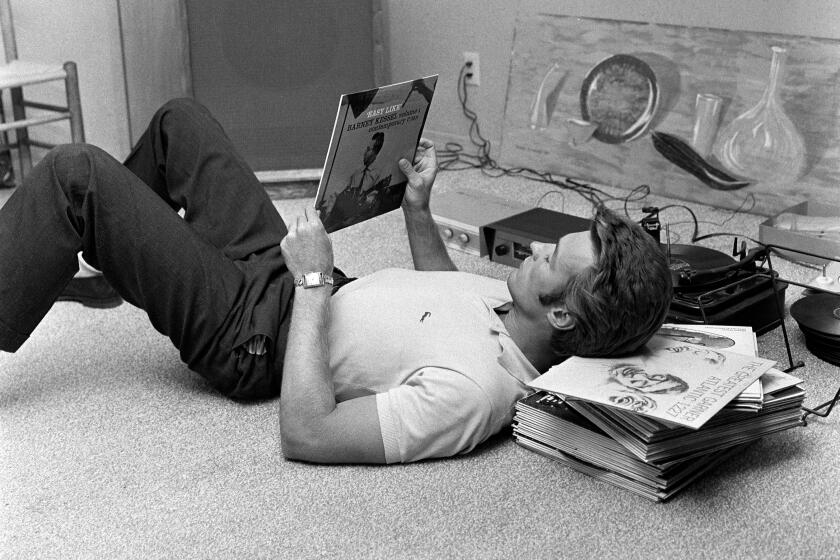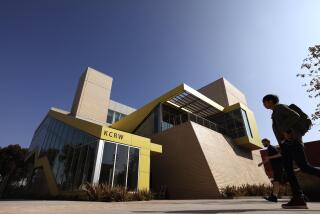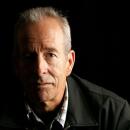How L.A. radio is responding to the coronavirus crisis
The coronavirus pandemic has sent millions of people around the globe daily, if not hourly, to their computers and smartphones for news updates, for entertainment and for a sense of connection and community with family members and friends in a time of ever-expanding government directives for sheltering at home.
For a significant audience, however, those options are not available, because many lack either the technology, or the desire, to be part of the virtual world of the internet. For them, a key ally remains one of the first avenues of mass communication: radio.
For the record:
2:26 p.m. March 25, 2020An earlier version of this post incorrectly included KNX-AM among the L.A. stations that are part of the iHeartMedia group. KNX is one of Entercom Communications Corp.’s L.A. radio outlets.
“I get into my car, and KUSC [FM classical music radio] takes me to a better place (psychologically, if not physically) immediately thank you!” Pasadena resident Loren A. Roberts wrote last week in appreciation to the USC-owned classical music station (91.5). Like many broadcasting operations in Southern California and around the world, the station has hastily arranged for its on-air personalities to continue their daily shows from home studios.
That goes for news operations including KNX-AM (1070), powerhouse music outlets such as KIIS-FM (102.7) and KROQ-FM (106.7), noncommercial stations such as Santa Monica-based KCRW-FM (89.9) and Pasadena’s KPCC-FM (89.3) and talk-radio channels including KFI-AM (640) and sports stations like KLAC-AM (570).
The latest updates from our reporters in California and around the world
It’s too early to have broadcast ratings information, but most stations are seeing increased listenership as the spread of the virus that causes COVID-19 has prompted more and more people to stay closer to home.
At KNX, the round-the-clock news station, “listening is up 44% this week, and up 55% compared to the prior two-week average,” according to John Pacino, senior vice president of product for Entercom Communications Corp., of which both KNX and KROQ are part of a network of 235 stations in 48 states. The increases are based on their streaming numbers, Pacino said.
Like nearly all broadcast radio stations today, Entercom’s member stations also stream their content, making it available to an audience far beyond the reach of its broadcast signal that covers most of Los Angeles and Orange counties.
“The thing that’s impressed me the most,” said KNX News Radio brand manager Ken Charles, “is the number of calls coming in from listeners saying, ‘Thank you for being out there and doing what you do.’ Most of the time you only hear from people when it’s something negative. This has been... ‘heartwarming’ is the only word that comes to mind, to hear positive messages from listeners who are appreciative of the efforts our staff is making.”
Officials at many stations said what listeners crave and appreciate even more than the news and other relevant information stations provide, or the diversion music and other non-news content allows, is the feeling of connection and stability during chaotic times.
“Our station motto is ‘Live and Local,’ and that’s what we’re doing,” said Isabel Gonzalez, content and brand director for reggaeton station Cali 93.9, part of the Burbank-based Meruelo Media group that also operates L.A. hip-hop station Power106, rock station KLOS-FM (95.5), and old-school hip-hop outlet KDAY-FM (93.5).
She cited a segment on Cali 93.9’s morning drive show in which local business owners are invited to call in, discuss their situations and encourage patrons to continue their support however they can during this time of social distancing.
“In the Hispanic community, we wear our emotions on our sleeves,” she said. “We are there for people to call in and explore how they’re feeling and what they’re going through.”
The same is true in other corners of the radio community.
“What people are looking for even more than music to comfort them is connection, and that’s what they get from the voices and the personalities they know,” KUSC President Judy McAlpine said. “KUSC’s Facebook page this week over last week showed a 479% increase in reach, and 2,565% increase in engagement. People need to engage with each other.
“They are also finding that the calming impact of classical music, paired with the human connection of our hosts, is a welcome respite right now,” McAlpine said.
With audiences stuck at home due to the coronavirus, streaming services are offering longer free trials and other deals. We round them up in this guide.
KUSC has been upfront with its listening audience, as are many other broadcasters. KUSC announcers such as Rich Capparela, Alan Chapman, Brian Lauritzen, John Van Driel, Dianne Nicolini, Jennifer Miller and others have uploaded photos or videos of themselves working in makeshift quarters in their homes.
In turn, listeners who are working from home, students who are out of school and parents looking for ways to keep their children engaged and comforted through a global crisis have posted expressions of empathy and solidarity.
“Thank you for keeping KUSC going amid this challenging time,” Los Angeles resident Cloe Yun wrote on the station’s Facebook page. “I’m happy that we have music to listen to and all you guys’ comforting human voices. :) Stay healthy!”
The connection between radio listeners and station personnel can cut both ways.
KROQ-FM brand manager Mike Kaplan spoke of the powerful impact on the staff when they learned that a longtime listener well-known at the station recently died of coronavirus.
Sal LoCurto, program director at National Public Radio affiliate KPCC said news content remains the station’s primary focus for now.
“We find our role as being a guide to helping everyone to understand what’s happening so quickly. L.A. specifically has been given a lot of information,” LoCurto said of measures instituted across the metropolis by Mayor Eric Garcetti. “We are setting records with engagement and email questions.”
How to keep Coronavirus stress at bay: Listen, really listen, to your favorite albums, front to back, without distraction.
During the coronavirus crisis, some stations are digging deeper into their vaults for programs such as vintage interview segments, concert specials and in-studio performances they’ve hosted.
One of the ways radio stations are adapting to the new safer-at-home reality is the morphing of public station KCRW’s 5 Things To Do This Week list of event recommendations.
“We’ve reconfigured that,” KCRW President Jennifer Ferro said. “Lindsay Preston Zappas, our art commentator, is normally talking about what’s going on in art galleries; now she’s doing things like, ‘Here’s an art project you can do at your house.’ We are reformulating how we connect with people.”
KCRW has a trove of in-studio music specials it has hosted with artists from Los Lobos and Tom Jones to Nashville indie singer-songwriter Soccer Mommy and experimental jazz musician Nate Mercereau that Ferro said the station is serving up as home quarantining and social distancing practices continue.
Mostly, however, she stressed the importance of the human connection.
“The thing I love most about radio is that live, real-time connection with a human voice,” she said. “At KCRW, we don’t program a bunch of stuff. We are live, we’re talking to you, and letting you know that we’re having the same experience you are.”
It’s a refrain that’s being heard across the board in radio.
“We’re in the friendship business, and that’s kind of what we’re maximizing right now,” said Tom Poleman, chief programming officer for iHeartMedia, the nation’s largest conglomerate of radio stations with 850 outlets, including KIIS-FM and KLAC 570 among its L.A. properties.
“Radio has always served our communities in times of need, whether that’s with information, companionship or escape from the world with entertainment,” said Poleman. “Now with people locked in their homes, we find they’re craving any sort of human interaction even more; they’re craving hearing voices that are familiar.”
That’s evident numerically, he said, in digital measurements showing usage for iHeart stations overall has increased 30% over smart speakers, 20% over the iHeart website and 22% through smart TV apps. Social engagement with on-air personalities has increased 19% and sharing of iHeart content over social media is up 97%, Poleman said.
“We’re putting artists and celebrities on the air constantly and listeners are hearing the same kinds of stories on how they’re coping with loneliness, changes of venue, how to pass the time,” Poleman said. “It reminds me a lot of how we were broadcasting after 9/11, which was another one of those times when you didn’t have a rule book.
“What seems to work best is just being honest,” he said, “and having regular conversations showing that you’re as vulnerable as your listeners.”
More to Read
The biggest entertainment stories
Get our big stories about Hollywood, film, television, music, arts, culture and more right in your inbox as soon as they publish.
You may occasionally receive promotional content from the Los Angeles Times.











